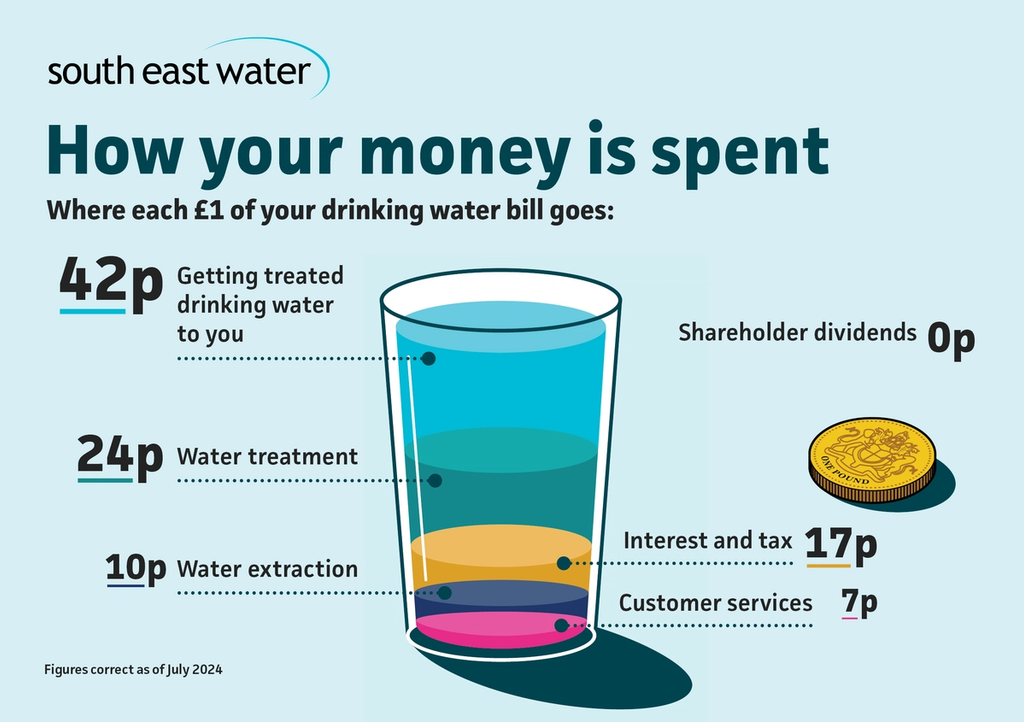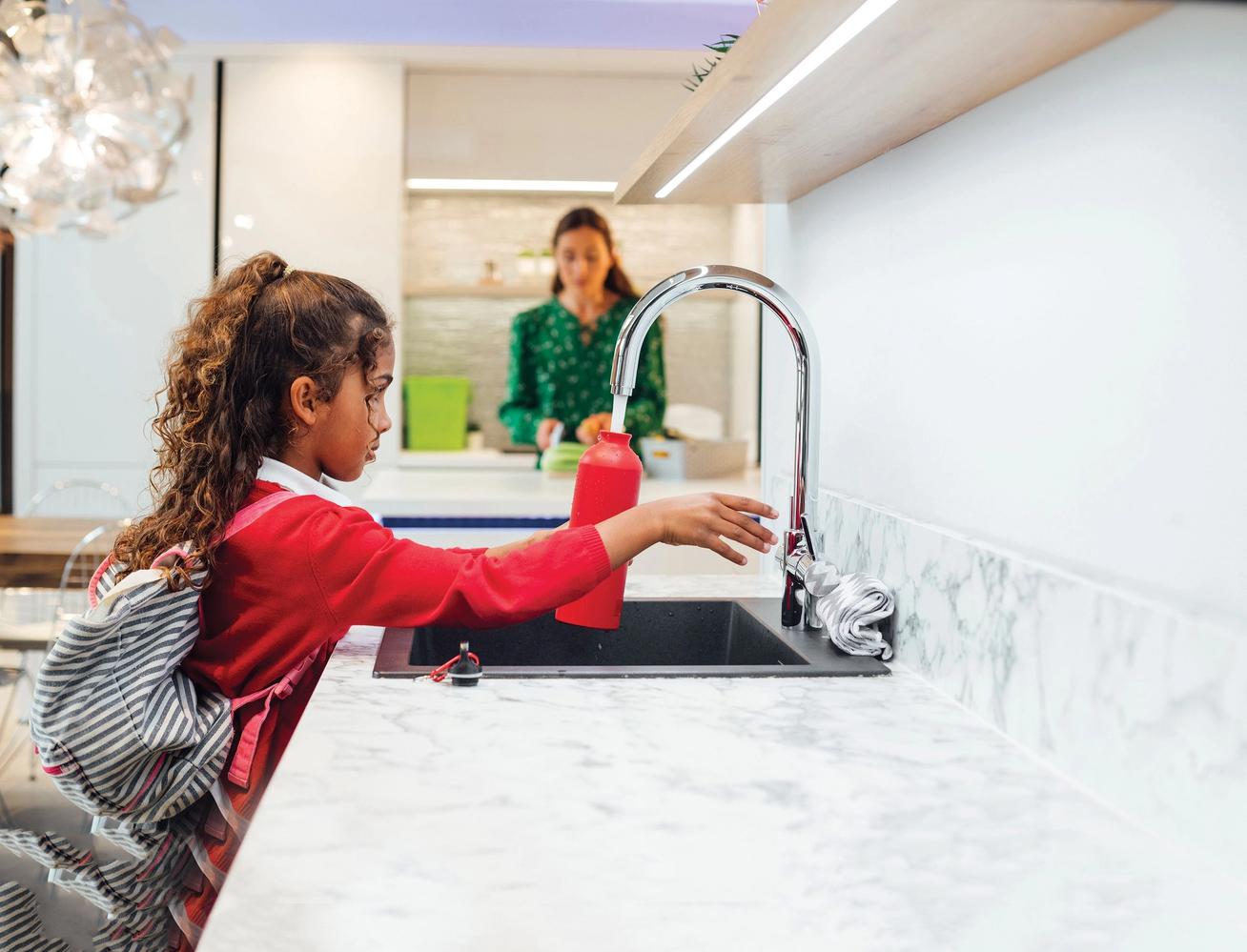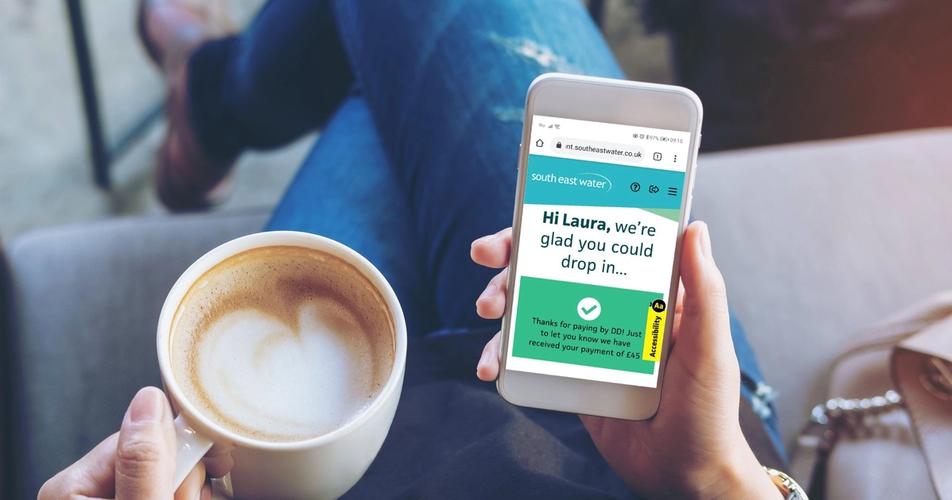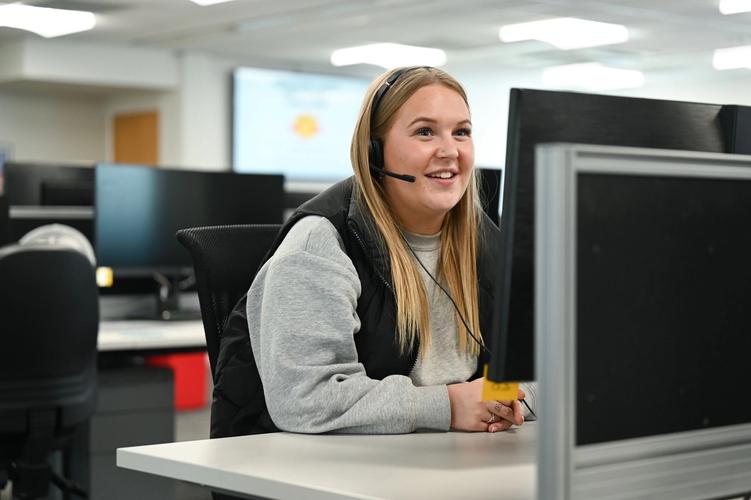We're sorry, we know a price rise is never welcome, especially alongside other cost of living increases. However, from 1 April 2025, the amount you pay for your drinking water will go up.
Why are prices going up?
The price we charge you is set by our regulator, Ofwat, who also decides how much we can invest in our network.
In the last five years, we have invested more than Ofwat has allowed us to, whilst keeping your prices the same.
To continue to provide your drinking water and make improvements to our public service, we now need to increase prices.
You can find out more about the price review process here(opens in a new tab).
How much is my bill going up?
The average water bill now costs 81p per day, which is less than the cost of a second-class stamp.
This is an increase of 20 per cent for an average bill. This includes all customers, and covers a range of tariffs - both metered and unmetered.
As a result the increase you see on your bill may be different from the average bill. We have published the full details of our water charges here.
What about waste water charges?
The waste water companies, such as Southern Water and Thames Water, have their own average increases, which are around 47 per cent.
It generally costs more to treat and remove the dirty water than it does to supply fresh water, so waste water charges tend to be higher.
We bill our customers for waste water services on behalf of Southern Water, Thames Water, Severn Trent Connect and Icosa Water.
We do this to make things simpler for our shared customers.
Not sure who your waste water supplier is? You can find this on your bill or use this link(opens in a new tab).
We have some FAQs(opens in a new tab) below that might help answer any further questions you might have.
What this means for you
If you pay monthly
You will see your monthly payment go up from March, this is because we split the total cost for the next bill period into equal payments. We do this so you pay the same amount each month, helping you to budget better.
If you’re on a meter and you pay your bill in full when it’s due
When you receive your next bill after 1 April 2025, you will see the price rise reflected in this bill.
If you’re not on a meter and you pay your bill in full or in instalments
The bill you have received most recently is for the period April 2025 to March 2026. You will see an increase in the price compared to your previous bill, to reflect the increases we are making.
Want to switch to a monthly payment plan?
Your opinion matters
We're always keen to hear what you have to say about us. We know a price rise is never welcome, so if you'd like to let us know your thoughts on our investment plans, please use our online contact form or complete and return the feedback form included within your most recent bill.
Struggling to pay?
Please don't worry.
We have a range of schemes to help. The best thing to do is to get in touch with us.

What the increase will fund

Across our entire operational area:
- Installing upgraded meters for you and your neighbours by 2035.
- Reducing the risk of drinking water outages by more of our sites having an alternative power source.
- Working with partners to improve the quality of raw water at the source, in rivers and in ground water.
- Reducing our carbon footprint by replacing petrol or diesel vehicles with electric.
- Continuing to tackle water poverty, increasing the support we give to our vulnerable customers.
In Kent
Improvements we've made recently:
- Keeping you in supply while we take a treated water storage tank out of service. We're doing this by laying a new pipeline to connect two existing pipes. Find out more here.
- Preventing flooding by managing the river flow at our site in Pembury.
- Upgrading our water treatment works in Pembury with new pumps.
- Increasing the amount of water we can take from the ground.
- Increasing the amount of fresh drinking water we can treat, which will ease pressure on wider areas of Kent. We’re doing this by building a state-of-the-art water treatment works near Aylesford, which will be able to treat an extra 20 million litres a day for the Ashford and Maidstone areas. Find out more here.
- Accelerating plans for a new reservoir near Canterbury. Once built, Broad Oak reservoir will help meet the future needs for drinking water in east Kent. It will also create new habitats, and provide countless social benefits for your local community. Find out more here.
New funding will help with:
- Multiple projects for reducing the risk of drinking water outages by giving us greater flexibility in our network. Including new pipelines, connecting different parts of the network and improvements at treated water storage tanks and water treatment works.
- Numerous environmental projects including the monitoring of invasive non-native species that can block pipes and cause harm to the environment, investigating levels of chemicals used on land above where we take groundwater from and working with farmers and landowners on alternate methods to using chemicals.
In Sussex
Improvements we've made recently:
- Protecting the quality of your drinking water by improving the environment. We’re doing this at Lullington Heath National Nature Reserve by boosting biodiversity, which means having a rich variety of life: from plants and animals to organisms and ecosystems. They will help protect the land above areas where we take groundwater from. This project is going to expand and link land at Eastbourne Downland, creating a Super National Nature Reserve.
- Using innovative technology and solar-powered remote meters to give farmers in the Litlington area live data on their drinking water use, helping them to identify leaks and use water on their farms wisely.
- Improving your drinking water quality by replacing a section of pipe on Turners Mill Road in Haywards Heath. Find out more here.
- Improving the environment by increasing biodiversity, which means having a rich variety of life: from plants and animals to organisms and ecosystems. We’ve done this by partnering with the Royal Botanic Gardens, Kew, to supply and install two Sand Martin nesting banks and two Tern nesting rafts. These are custom made ‘floating hotels’ for birds to nest above the water, safe from predators, currents in the water and flooding. Find out more by watching our video here.
New funding will help with:
- Developing long-term plans for a new reservoir at Arlington, as well as exploring other water resource solutions to make sure right plans are chosen.
- Reducing the risk of drinking water outages by increasing the amount of water we can treat and store.
In Berkshire, Hampshire and Surrey
Improvements we've made recently:
- Future-proofing as the communities grow between Hale and Aldershot. We’re doing this by laying new pipes that will increase the capacity of drinking water we can supply to homes and businesses. Find out more here.
- Protecting the Maidenhead Ditch stream to keep it healthy and sustainable for the future. We're doing this by making the river flow better, preventing flooding and creating new habitats. Find out more here.
New funding will help with:
- Moving drinking water around more easily by installing multiple new pipelines.
- Numerous environmental projects ranging from restoring sites of special scientific interest (SSSI) to reducing chemicals and other substances from running into rivers and seeping into groundwater.
FAQs
We’re sorry, we know a price rise is never welcome, especially alongside other cost of living increases. However, to make sure we continue to invest in making your drinking water supply more reliable by reducing leaks and improving our network, we need to increase investment and therefore prices.
The average drinking water bill now costs 81p per day, less than the cost of a second-class stamp - this is an increase of 20%.
This includes all customers, and covers a range of tariffs - both metered and unmetered.
As a result the increase you see on your bill may be different from the average bill. 20% is the increase for the drinking water part of your bill.
The waste water companies, such as Southern Water and Thames Water, have their own average increases, which are around 47%.
When compared to the price of bottled water, your water still remains extremely good value for money.
No dividends have been paid to our shareholders since 2019 and there are no plans to pay any in the next financial year.
Water bill rises are often “front-loaded” - meaning that the biggest increases occur in the first year. This allows us, and all water companies, to quickly fund the substantial infrastructure upgrades needed during the next 5-year period.
The average drinking water bill now costs 81p per day - this is an increase of 20%. This includes all customers, and covers a range of tariffs - both metered and unmetered. As a result the increase you see on your bill may be different from the average bill.
20% is the increase for the drinking water part of your bill. The waste water companies, such as Southern Water and Thames Water, have their own average increases, which are around 47%.
Generally it costs more to treat and remove the dirty water than it does to supply fresh water, so waste water charges tend to be higher.
We bill our customers for waste water services on behalf of Southern Water, Thames Water, Severn Trent Connect and Icosa Water. We do this to make things simpler for our shared customers.
If you are on a water meter
You are charged for the amount of water you use. Your latest bill will show how much water is being used at your home. Look for ‘charge type’ within your bill to see the amounts.
If you are not on a water meter
Prices may vary depending on the size of your property or how you are billed. We use either your property’s rateable value or an assessed charge.
An assessed charge is used when we’ve not been able to install a water meter at the property. We will assess your charges for water, usually based on the number of bedrooms in your property, irrespective of the number of occupiers.
Look for ‘charge type’ within your bill to see if your property is ‘rateable value’ or for the number of bedrooms on an assessed charge.
There are many other factors involved around how water companies set their prices (no two companies charge the same), and this can be down to the nature of the areas that the companies supply, rural areas versus city areas for example, or where they take water from. Here at South East Water, the majority of our water comes from underground water sources, contained in rare chalk aquifers (a type of rock that allows water through it), and we have lots of rural areas meaning more pipework is required to reach these areas compared to city areas where properties are closer together.
Yes they are. These water companies announced a price rise on the same day as us. Like us, all of the water companies have gone through a price setting process and assessed what their prices need to be to ensure they continue to remove waste water effectively for their customers.
The waste water companies have their own average increases, which are around 47%. Generally it costs more to treat and remove the dirty water than it does to supply fresh water, so waste water charges tend to be higher.
You can find out more on their websites:
www.southernwater.co.uk(opens in a new tab)
www.thameswater.co.uk(opens in a new tab)
Generally it costs more to treat and remove the dirty water than it does to supply fresh water, so waste water charges tend to be higher.
We bill our customers for waste water services on behalf of Southern Water, Thames Water, Severn Trent Connect and Icosa Water. We do this to make things simpler for our shared customers.
The waste water companies have their own average increases, which are around 47%.
If you’re struggling to pay your bill, we do have a range of schemes to help. The best thing to do is to get in touch and we'll do all we can for you. We can look if there are alternative tariffs that may be available to suit your circumstances and we could also look at some water saving tips which could help to reduce your water bill.
From April 2025, the Social Tariff will apply a tiered discount based on the household income. For customers earning between £17,000 and £21,000 a 30 per cent discount will be applied, rising to 50 per cent for households with an income of less than £17,000.
If you currently receive a discount under our Social Tariff, please note that this will remain unchanged and you will continue to receive the same level of discount as you do now. If you think you would receive a greater benefit from one of the new tiers under our Social Tariff please let us know.
Please call our dedicated Customer Service team on 0333 000 0001(opens in a new tab). All our advisors are specially trained to offer confidential advice and support. Lines are open Monday to Friday from 8am to 7pm and Saturday from 8am to 1pm.
There is a lot of work that goes into making your water safe to drink, meeting the high standards set by the Drinking Water Inspectorate, and ensuring that we have enough water available to meet our customers’ demands.
The majority of the water we supply comes from underground, which is rainwater that has filtered deep down into the aquifers (a type of rock that allows water through it) below ground. We also have reservoirs above ground, that collect rain water and we use in the summer months for the millions of additional litres we need to supply.
Depending on where the water comes from (above or below ground) and the location of the groundwater (there are lots of different types of rock/aquifers), this will determine the amount of treatment the water needs to bring it up to standard. This can sometimes be quite complex and more costly.
The cost of moving water around the network is also very significant as electricity is required to pump water from boreholes to customer homes, particularly in areas on higher ground.
All of the investment that we need to undertake to keep providing an excellent quality of water to all of our customers is detailed in our business plan. You can read it here: southeastwater.co.uk/businessplan
The water regulator, Ofwat, sets the prices we can charge you and also decides how much we can invest. They ensure we keep our charges fair and as low as we can, and Ofwat constantly challenges us to create efficiencies.
The amount we charge is needed to collect, clean and pump water to your home, and includes the day-to-day running costs of our business. It also supports investments that maintain and improve our network of water pipes, pumping stations and treatment works and allows us to develop new water resources.
We’re committed to providing your public drinking water service and have invested more than the regulator allowed us to in the last five years, whilst keeping your prices the same.
To make sure we continue to invest in making your drinking water supply more reliable by reducing leaks and improving our network, we now need to increase investment and therefore prices.
All of the investment that we need to undertake to keep providing an excellent quality of water to all of our customers is detailed in our business plan. You can read it here.
We work around the clock to stop water being wasted through leaking pipes.
Bursts and leaks are unfortunately inevitable because we have 543 million litres of water a day being transported around 9,000 miles of underground pipes – enough to stretch from the UK to Australia – and 900,000 customer connections.
We have 60 teams repairing leaks reactively and 86 leakage technicians and analysts searching for and find leaks proactively. In 2024 we repaired more than 25,000 leaks.


